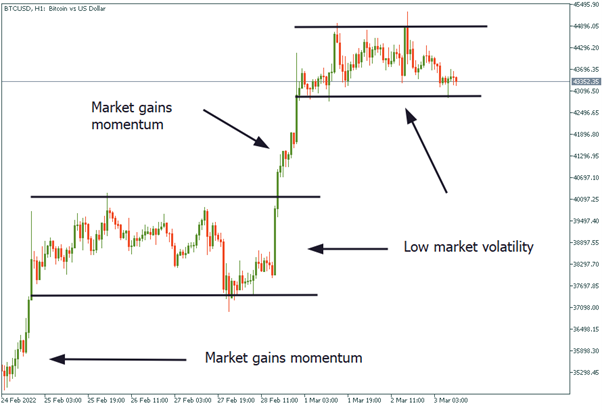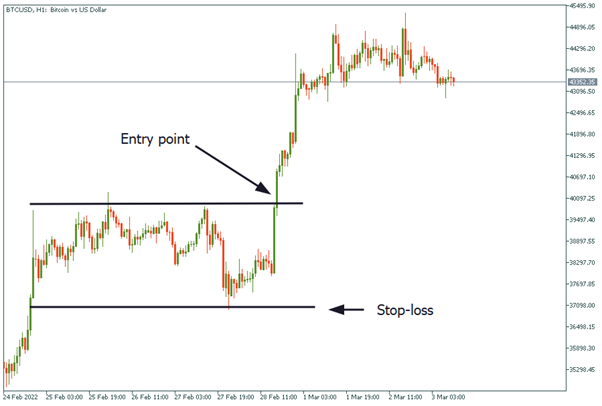Berdagang dengan sistem breakout kemeruapan
Kadang kala harga di pasaran naik dan turun dengan mendadak, dan kadang kala pasaran tenang. Sesetengah daripada pakar menyamakan pasaran dengan laut. Apabila laut tenang, tiada ombak kelihatan. Namun, jika ribut melanda, ombak boleh mencecah sehingga beberapa meter.
Apakah itu kemeruapan?
Kemeruapan mencerminkan momentum dalam pasaran. Pasaran yang sangat meruap akan memperlihatkan banyak pergerakan. Seorang pedagang dengan mudah boleh membezakan detik kemeruapan pasaran yang tinggi dengan melihat pada carta. Jika terdapat naik turun harga yang besar, ia adalah kemeruapan pasaran. Sebaliknya, kemeruapan adalah rendah sekiranya harga diurusniaga di dalam julat dengan swing yang minimum.
Salah satu cara untuk mengukur kemeruapan aset ialah dengan mengira pergerakan harian (peratusan pergerakan harian). Sejarah kemeruapan adalah berdasarkan sejarah harga dan ia mewakili tahap kebolehubahan dalam pulangan.
Setiap pasaran mengalamai kemeruapan yang tidak menentu. Sebagai contoh, kita boleh lihat perbezaan pergerakan harga pada tempoh yang berlainan pada carta di bawah. Kadang kala ia membuat pergerakan yang signifikan. Pada masa lain semasa kemeruapan rendah, harga diurusniaga dalam julat yang kecil.
Dengan melihat carta, para pedagang boleh melihat waktu satu instrumen itu mengalami tempoh kemeruapan yang tinggi dan rendah. Ia mewujudkan peluang untuk pedagang tersebut menggunakan kaedah breakout kemeruapan.
Perdagangan breakout kemeruapan menggunakan sokongan & rintangan
Matlamat utama untuk seorang pedagang yang menggunakan strategi breakout kemeruapan ialah mengenalpasti waktu kemeruapan meningkat. Pedagang perlu mengenalpasti waktu apabila pasaran bertukar daripada mod ranging kepada trending. Para pedagang boleh menggunakan sistem ini pada mana-mana rangka masa dan pada semua jenis pasaran. Terdapat pelbagai kaedah, perkakas-perkakas berguna, dan indikator-indikator.

Carta di atas menunjukkan satu contoh jenis perdagangan breakout kemeruapan yang paling asas. Kita boleh lihat bahawa harga permulaan adalah trending dengan lebih tinggi dengan kemeruapan yang tinggi dalam pasaran. Namun, pada pertengahan carta, ia menurun dan berada dalam julat oleh kerana kemeruapan menurun.

Apabila pedagang melihat harga yang perlahan seperti ini, beliau boleh terus melukis garisan sokongan dan rintangan, dan menanda swing tertinggi dan terendah semasa pasaran reda. Selepas itu, pedagang tersebut perlu memerhatikan pasaran, menunggu breakout pada julat ini, dan mengikuti trend.
Perdagangan breakout kemeruapan dengan trend
Perlu diingatkan bahawa sistem breakout kemeruapan berfungsi dengan lebih baik ketika penyambungan trend berlaku. Dalam gambar di bawah, harga sedang trending menaik sebelum julat bermula. Sekiranya harga menembusi garisan rintangan, pedagang akan memasuki pasaran. Sekiranya harga menembusi bawah julat, ini akan menjadi perdagangan berlawanan trend dan ia tidak disukai oleh pedagang yang berdagang menggunakan sistem ini.
Sistem ini sangat mudah dan tidak rumit kerana ia hanya bergantung kepada kebolehan seorang pedagang untuk melukis garisan-garisan sokongan dan rintangan. Pedagang boleh menetapkan pesanan harga tertangguh di atas aras rintangan bagi bersedia untuk breakout kemeruapan sekiranya ia tidak kelihatan pada carta. Pesanan tersebut dipanggil ‘Buy Stop’.
Dalam senario ini, pedagang membuka urusniaga beli hanya selepas harga tersebut menembusi aras rintangan. Untuk pengurusan risiko, mereka perlu meletakkan pesanan Renti Rugi di bawah garisan sokongan julat tersebut. Dalam kes ini, sasaran perlulah sekurang-kurangnya dua kali keuntungan daripada risiko yang telah ditetapkan. Kaedah ini akan membantu pedagang untuk mencapai nisbah perdagangan risiko-ganjaran yang positif.
Perdagangan breakout kemeruapan dengan indikator
Ramai pedagang menambah baik strategi ini dengan indikator teknikal, yang mana sangat berguna untuk perdagangan pertambahan kemeruapan. Bollinger Bands merupakan salah satu indikator paling popular yang digunakan bagi tujuan tersebut.
Bollinger Bands adalah indikator teknikal yang digunakan untuk mengukur kemeruapan dan arah trend. Indikator tersebut terdiri daripada purata bergerak 20 tempoh (garisan di tengah jalur) dan jalur atas dan bawah yang menandakan dua sisihan piawai yang lebih dan kurang daripada purata. Kegunaan indikator ini adalah untuk mengukur kemeruapan dalam pasaran dan mengenalpasti trend. Julat yang besar di antara jalur memberikan petunjuk kemeruapan pasaran yang tinggi. Sebaliknya, jalur yang sempit bermaksud kemeruapan berkurangan dan pasaran diurusniaga di dalam julat. Selain dari itu, arah BB tersebut akan membantu para pedagang menentukan samada ia trend menaik atau menurun.

Carta di atas menunjukkan betapa bergunanya indikator ini. Pertama, ia menunjukkan trend. Selain itu, indikator tersebut menunjukkan tempat pada carta dengan kemeruapan yang tinggi, dan juga tepat dimana harga membuat pengukuhan.
Indikator BB menguncup apabila harga berhenti seketika dan mengukuh sejak pasaran kehilangan kemeruapan. Namun, sebaik sahaja harga menembusi jalur atas, kemeruapan kembali dan ia menunjukkan trend bullish bersambung.
Menurut strategi ini, pedagang perlu melakukan urusniaga sebaik sahaja harga menembusi bahagian atas jalur. Dalam kes ini, perlu diingatkan bahawa Renti Rugi perlu diletakkan di bawah sempadan bawah jalur.
Terdapat dua pilihan untuk mengurus dagangan ini. Pertama, anda boleh mengikut sahaja tetapan sebelum ini dan tetapkan pesanan Ambilan Untung dua kali ganda daripada risiko, iaitu Renti Rugi. Selain dari itu, anda boleh gunakan indikator Bollinger Bands untuk mengurus dagangan ini.
Seperti yang anda tahu, garisan tengah indikator Bollinger Bands adalah purata bergerak. Justeru, para pedagang boleh mengurus dagangan ini menggunakan kaedah yang sama apabila berdagang dengan menggunakan purata bergerak: biarkan urusniaga terbuka sehingga ia menyentuh purata bergerak kerana ia menandakan bahawa trend sudah kehilangan momentum.
Pendekatan lain menggunakan Bollinger Bands, ialah pedagang mengekalkan urusniaga terbuka sehingga harga menyentuh jalur bawah. Harga akan turun ke bawah dan menyentuh bawah Bollinger Bands. Ini bermakna harga sama ada menetap dalam julat yang lain dan pedagang boleh mengambil untung dan menunggu peluang lain untuk membuka posisi beli, atau harga berpotensi menyongsang.
Kesimpulan
Strategi breakout kemeruapan adalah salah satu strategi perdagangn yang mempunyai kadar keuntungan yang tinggi. Ia boleh digunakan pada semua jenis pasaran dan rangka masa. Selain itu, ia sangat mudah untuk dipelajari dan digunakan, kerana ia hanya memerlukan ilmu berkenaan paras sokongan dan rintangan, dan mengenalpasti trend. Strategi ini sangat sesuai newbie dan pedagang berpengalaman kerana ia kebolehubahannya dan kebarangkalian peningkatan tanpa had.